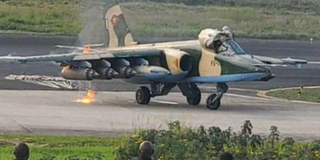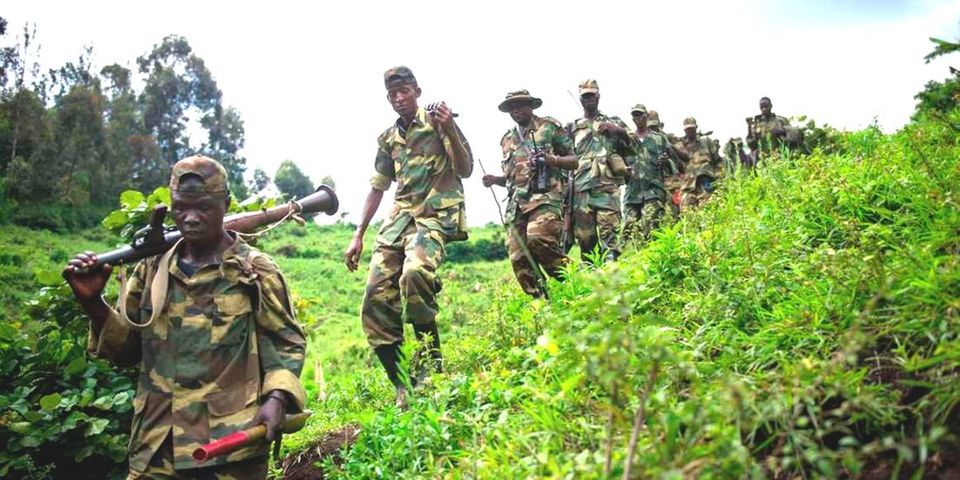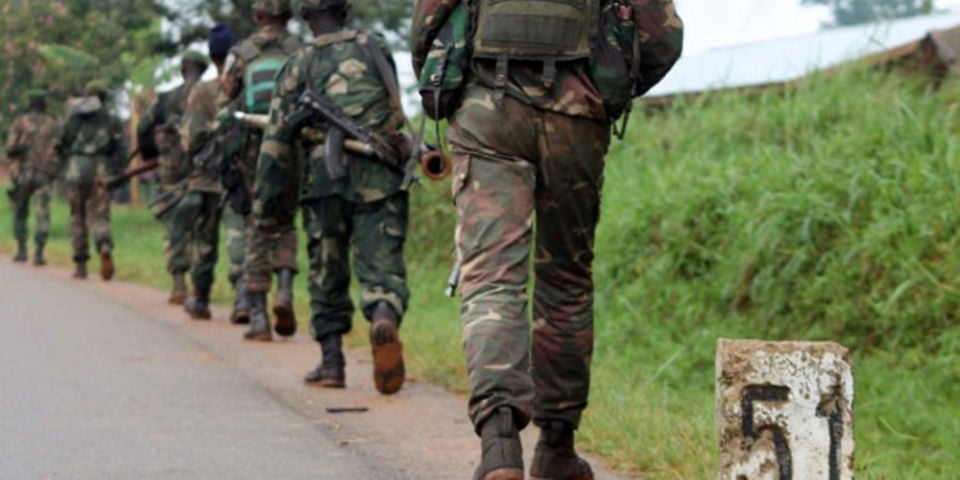Prime
What next as DRC, Rwanda square up?

A DRC Sukhoi Su-25 at Goma airport shortly after it was hit and damaged by Rwanda Defence Force. PHOTO/FILE
What you need to know:
- The conflict dates way back, but it was in 2021 when the current standoff between Rwanda and the DRC flared up.
The Democratic Republic of the Congo (DRC) was supposed to hold the Great Lakes region spellbound at the tail end of this year by staging both its parliamentary and presidential elections.
With relations between the big mineral-rich country and its tiny eastern neighbour, dissolving into acrimony, the DRC already has many sitting up to take notice in the first month of 2023.
In a further escalation of hostilities, Rwanda on Tuesday revealed that it was behind a blow that a Congolese fighter jet took.
Videos emerged on social media showing a Sukhoi Su-25 rattled by a surface-to-air projectile. The fighter jet—one of two on Kinshasa’s books—stuttered its way to Goma airport, in the eastern DRC, where a fire was put out.
Which of the two countries is at fault in the latest spat?
Although people who are familiar with aviation insist that it is impossible for any plane, be it civilian or military, to land at Goma airport without deviating into Rwanda, Kigali hastily released a statement accusing the DRC of illegally veering into its territory.
“Today at 5:03pm, a Sukhoi from DR Congo violated Rwanda Airspace for the third time. Defensive measures were taken. Rwanda asks the DRC to stop this aggression,” the terse statement said.
In a lengthier statement, Kinshasa described the shooting as a “deliberate act of aggression that amounts to an act of war.” It went on to reveal that the development was aimed at undermining a peace agreement to end an offensive by the M23 rebels, who have taken a number of towns in the eastern DRC.
When did relations between the two countries start breaking down?
The conflict dates way back, but it was in 2021 when the current standoff between Rwanda and the DRC flared up. Back then, the primarily defunct M23 militant group carried out lightning strikes on the positions of the Congolese military in the villages of Chanzu and Runyonyi in North Kivu Province—just west of the Ugandan and Rwandan borders.
This occurred during the same month that Ugandan forces were deployed to the province to pursue the Allied Democratic Forces (ADF), a Ugandan rebel group that also operates in North Kivu and Ituri. Uganda had been the target of suicide bomb attacks that President Museveni blamed on the ADF.
In 2022, the M23 fighters who are mainly ethnic Tutsi and are accused of being directly backed by Mr Paul Kagame—the Rwandan president who is a Tutsi—claimed large swathes of the eastern DRC.
This also included the vital border town of Bunagana. When the rebels seized Kiwanja and Rutshuru in the Congolese province of North Kivu, Kinshasa expelled Mr Vincent Karega—Rwanda’s ambassador to the DRC. All of this has turned the eastern DRC into a tinderbox.
“There are a lot of provocations from either side. If the Congo indeed veered into Rwandan territory, Rwanda was right to defend itself,” Mr Solomon Asiimwe, a lecturer of intentional relations at Nkumba University, said. “If the plane was in Congolese territory then Rwandan actions will bring a lot of challenges because it’s against the UN charter.”
Mr Asiimwe reckons that the DRC “can’t start an outright war with Kigali” not least because the former “have so many problems.”
What are the historical roots of the standoff?
In 1996, the Rwandan army made incursions into the North and South Kivu provinces of DRC purportedly to extinguish the remaining forces of the former Rwandan regime. Rwanda didn’t stop at fighting the Hutu rebels. It formed a coalition with Uganda that backed Laurent Désiré Kabila who ended Mobutu Sese Seko’s 32-year grip on the DRC.
Since then, Rwanda and Uganda have played a central role in destabilising the DRC through the support of various militias. Having fallen out with Kabila, the Rwandan army launched an ambitious—but ultimately ineffective—operation to take over the DRC capital, Kinshasa.
The operation called Kitona saw the RDF lock horns with its former allies—the UPDF. The pair reportedly maintained troops through pillage and plunder in the eastern DRC.
The Rwandan regime also increased, according to Mr Federico Donelli—a researcher in International Relations at the University of Genoa, its grip over the provinces of North and South Kivu through alliances with various armed groups.
These included Tutsi militias of the Congolese Banyamulenge and the Rally for Congolese Democracy (RCD) rebels who were based in Goma between 1998- 2003.
“Fourteen months after Kabila overthrew President Mobutu Sese-Seko, a coalition of groups formed the RCD and rebelled against him. The new movement included some former supporters of Kabila, particularly Congolese members of the Tutsi ethnic group, former political and military supporters of Mobutu, and a number of intellectuals,” a Human Rights Watch report pointed out.
“The RCD received support from the governments of Rwanda and Uganda as it moved westward, attempting to replicate the rapid success of the forces that had installed Kabila in power. But the governments of Angola, Zimbabwe, Namibia, and Chad came to Kabila’s aid and slowed their advance,” the report stated.
Later on, the RDC split, with the Rwandan government choosing to back what was christened as the RCD-Goma. In 2006, Rwanda stood accused of backing the National Congress for the Defence of the People or CNDP led by renegade Tutsi general, Laurent Nkunda. Its stated mission was to defend, protect, and ensure political representation for the several hundred thousand Congolese Tutsi living in eastern Congo as well as about 44,000 Congolese refugees—most of them Tutsi—living in Rwanda.
In January 2019, Nkunda was sentenced to 30 years in prison by the International Criminal Court for war crimes. The punishment came after he had formed the M23 Movement.
If this isn’t a forever standoff, what does an endgame look like?
The current standoff is not the first time Rwanda is accusing the DRC of encroaching into its airspace. In December last year, Rwanda said a Sukhoi-25 had violated its airspace just a month after another aircraft landed at the ‘wrong’ airport on the Rwandan side instead of the Congolese one.
“A Sukhoi-25 fighter jet from the Democratic Republic of Congo (DRC) violated Rwandan airspace along Lake Kivu in the Western Province of Rwanda today at around 12:00pm, and immediately returned to the DRC. Rwandan authorities have once again protested to the DRC government against the violations of Rwandan airspace by DRC fighter jets,” a statement from Kigali said.
In spite of the clear military advantages Kigali has over Kinshasa, the latter have remained bullish in part because they appear to have the support of the Americans and the French on the M23 issue. Kinshasa was also buoyed when Turkey delivered an assortment of weapons it intends to use to ward off the M23 rebels.
Lt Gen Ndima, the military governor of North Kivu, after receiving the equipment from Ankara, said the weapons “…. will strengthen the Congolese army units on the frontlines against several armed groups and the M23.”
“The DRC is counting a lot on this cooperation which will surely produce good fruits in the future, for the well-being of the Congolese and Turkish brother peoples,” he said.
Although the tensions and sabre rattling might be high, it’s highly unlikely that it will translate into an all-out war between Rwanda and the DRC.
“The Americans have shown a keen interest. The Europeans have also shown a keen interest. Even the regional neighbours have put together a force. So, I don’t see how Rwanda declares war. It’s most likely they will continue to fight through proxies,” Mr Asiimwe said.
How does the DRC militarily stack up against Rwanda?
The DRC has for years on end been renowned for its feeble, disjointed and to some extent dysfunctional army. Thomas Mandrup, an associate professor at Stellenbosch University, wrote in a paper that while implementation of “a biometric payment system … significantly improved salary payment to the soldiers … corruption and misuse of funds is still a challenge, soldiers only get a portion of their pay via this system.”
The ineptness of the Congolese army explains why it is riding piggyback on the East African Community Regional Force to stave off the M23 rebels.
“If the Congolese army was capable then it wouldn’t have called Kenya, Uganda and other countries to fight those rebels,” Mr Asiimwe said, adding, “The mere fact they are calling other countries is an indicator that their army has no capacity to fight.”
While the Congolese army is struggling to flush out rebel groups and militias from its dense jungles, the Rwandan army has for years built an image of professionalism. It is a leading contributor to peace missions in Africa.
“Beginning in 2005, the RDF [Rwanda Defence Forces] assumed its new role as an instrument used to further Kagame’s continental and international agenda,” Mr Gerard Prunier wrote in his book titled the Armies of the Great Lakes Countries.
“The need to re-establish severed political ties, overcome Rwanda’s economic isolation and the desire to rebrand the country’s poor image influenced the newly- elected Kagame to begin the RDF’s active involvement in multilateral operations,” Mr Prunier wrote.
Working under the auspices of the United Nations, Rwandan troops soon, Prunier notes, “received much praise, especially for their skill in transnational mediations and operations in civil war contexts.” RDF’s expertise and discipline have in time been noticed and are in stark contrast with other peacekeeping contingents.
In particular, Prunier says the Rwandan peacekeepers have not been involved in the repetitive sex abuses that have tarnished the UN peacekeeping missions in Africa and embarrassed the UN Security Council. Although Rwanda has been bragging about the capacity of its military, it has failed to defeat the FDLR rebels. Kigali says the rebels found a safe haven in the DRC after the 1994 Rwandan genocide.





